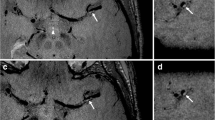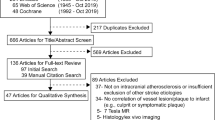Abstract
Purpose
Data on evolution of intracranial plaques in acute ischemic stroke patients after receiving medical therapy is still limited. We aimed to investigate the plaque features associated with culprit lesions and to explore the plaque longitudinal changes during treatment using high-resolution vessel wall MR imaging (VW-MRI).
Methods
Twenty-three patients (16 men; mean age, 51.4 years ± 11.1) with acute ischemic stroke underwent 3-T VW-MRI for intracranial atherosclerosis and were taken follow-up assessments. Each identified plaque was retrospectively classified as culprit, probably culprit, or nonculprit. Plaque features were analyzed at both baseline and follow-up and were compared using paired t-test, paired Wilcoxon test, or McNemar’s test.
Results
A total of 87 intracranial plaques were identified (23 [26.4%] culprit, 10 [11.5%] probably culprit, and 54 [62.1%] nonculprit plaques). The median time interval between initial and follow-up MRI scans was 8.0 months. In the multiple ordinal logistic regression analysis, plaque contrast ratio (CR) (OR, 1.037; 95% CI, 1.013–1.062; P = 0.002) and surface irregularity (OR, 4.768; 95% CI, 1.064–21.349; P = 0.041) were independently associated with culprit plaques. During follow-up, plaque length, maximum thickness, normalized wall index (NWI), stenosis degree, and CR significantly decreased (all P-values < 0.05) in the culprit plaque group. The plaque NWI and CR dropped in the probably culprit plaques (P = 0.041, 0.026, respectively). In the nonculprit plaque group, only plaque NWI and stenosis degree showed significant decrement (P = 0.017, 0.037, respectively).
Conclusion
Follow-up VW-MRI may contribute to plaque risk stratification and may provide valuable insights into the evolution of different plaques in vivo.



Similar content being viewed by others
Abbreviations
- ICAD:
-
Intracranial atherosclerotic disease
- VW-MRI:
-
Vessel wall MR imaging
- NWI:
-
Normalized wall index
- CR:
-
Contrast ratio
References
Yaghi S, Prabhakaran S, Khatri P, Liebeskind DS (2019) Intracranial atherosclerotic disease. Stroke 50:1286–1293
Qureshi AI, Caplan LR (2014) Intracranial atherosclerosis. The Lancet 383:984–998
Hoshino T, Sissani L, Labreuche J et al (2018) Prevalence of systemic atherosclerosis burdens and overlapping stroke etiologies and their associations with long-term vascular prognosis in stroke with intracranial atherosclerotic disease. JAMA Neurol 75:203
Nahab F, Cotsonis G, Lynn M et al (2008) Prevalence and prognosis of coexistent asymptomatic intracranial stenosis. Stroke 39:1039–1041
Kim BJ, Hong K-S, Cho Y-J et al (2014) Predictors of symptomatic and asymptomatic intracranial atherosclerosis: what is different and why? J Atheroscler Thromb 21:605–617
Chung J-W, Cha J, Lee MJ et al (2020) Intensive statin treatment in acute ischaemic stroke patients with intracranial atherosclerosis: a high-resolution magnetic resonance imaging study (STAMINA-MRI Study). J Neurol Neurosurg Psychiatry 91:204–211
Zhang X, Chen L, Li S et al (2020) Enhancement characteristics of middle cerebral arterial atherosclerotic plaques over time and their correlation with stroke recurrence. J Magn Reson Imaging 53:953–962
Ni J, Yao M, Gao S, Cui L-y (2011) Stroke risk and prognostic factors of asymptomatic middle cerebral artery atherosclerotic stenosis. J Neurol Sci 301:63–65
Mandell DM, Mossa-Basha M, Qiao Y et al (2017) Intracranial vessel wall MRI: principles and expert consensus recommendations of the American Society of Neuroradiology. Am J Neuroradiol 38:218–229
Qiao Y, Anwar Z, Intrapiromkul J et al (2016) Patterns and implications of intracranial arterial remodeling in stroke patients. Stroke 47:434–440
Qiao Y, Zeiler SR, Mirbagheri S et al (2014) Intracranial plaque enhancement in patients with cerebrovascular events on high-spatial-resolution MR images. Radiology 271:534–542
Lu Y, Ye M-f, Zhao J-j et al (2021) Gadolinium enhancement of atherosclerotic plaque in the intracranial artery. Neurol Res 43:1040–1049
Skarpathiotakis M, Mandell DM, Swartz RH, Tomlinson G, Mikulis DJ (2013) Intracranial atherosclerotic plaque enhancement in patients with ischemic stroke. Am J Neuroradiol 34:299–304
Leung TA-O, Wang L, Zou X et al (2021) Plaque morphology in acute symptomatic intracranial atherosclerotic disease. J Neurol Neurosurg Psychiatry 92:370–376
Kwee RM, Qiao Y, Liu L, Zeiler SR, Wasserman BA (2019) Temporal course and implications of intracranial atherosclerotic plaque enhancement on high-resolution vessel wall MRI. Neuroradiology 61:651–657
Yang W-J, Abrigo J, Soo YO-Y et al (2020) Regression of plaque enhancement within symptomatic middle cerebral artery atherosclerosis: a high-resolution MRI study. Front Neurol 11:755
Fakih R, Roa JA, Bathla G et al (2020) Detection and quantification of symptomatic atherosclerotic plaques with high-resolution imaging in cryptogenic stroke. Stroke 51:3623–3631
Xiao J, Padrick MM, Jiang T et al (2021) Acute ischemic stroke versus transient ischemic attack: Differential plaque morphological features in symptomatic intracranial atherosclerotic lesions. Atherosclerosis 319:72–78
Yang W-Q, Huang B, Liu X-T, Liu H-J, Li P-J, Zhu W-Z (2014) Reproducibility of high-resolution MRI for the middle cerebral artery plaque at 3T. Eur J Radiol 83:e49–e55
Zhang T, Tang R, Liu S et al (2020) Plaque characteristics of middle cerebral artery assessed using strategically acquired gradient echo (STAGE) and vessel wall MR contribute to misery downstream perfusion in patients with intracranial atherosclerosis. Eur Radiol 31:65–75
Liu S, Luo Y, Wang C et al (2019) Combination of plaque characteristics, pial collaterals, and hypertension contributes to misery perfusion in patients with symptomatic middle cerebral artery stenosis. J Magn Reson Imaging 51:195–204
Wu F, Ma Q, Song H et al (2018) Differential features of culprit intracranial atherosclerotic lesions: a whole-brain vessel wall imaging study in patients with acute ischemic stroke. J Am Heart Assoc 7:e009705
Lee HN, Ryu C-W, Yun SJ (2018) Vessel-wall magnetic resonance imaging of intracranial atherosclerotic plaque and ischemic stroke: a systematic review and meta-analysis. Front Neurol 9:1032
Song JW, Pavlou A, Xiao J, Kasner SE, Fan Z, Messé SR (2021) Vessel wall magnetic resonance imaging biomarkers of symptomatic intracranial atherosclerosis. Stroke 52:193–202
Qiao Y, Etesami M, Astor BC, Zeiler SR, Trout HH, Wasserman BA (2012) Carotid Plaque neovascularization and hemorrhage detected by MR imaging are associated with recent cerebrovascular ischemic events. Am J Neuroradiol 33:755–760
Wang J, Chen H, Sun J et al (2017) Dynamic contrast-enhanced MR imaging of carotid vasa vasorum in relation to coronary and cerebrovascular events. Atherosclerosis 263:420–426
Portanova A, Hakakian N, Fau-Mikulis DJ et al (2013) Intracranial vasa vasorum: insights and implications for imaging. Radiology 267:667–679
Samaniego EA, Roa JA, Zhang H et al (2020) Increased contrast enhancement of the parent vessel of unruptured intracranial aneurysms in 7T MR imaging. J Neurointerv Surg 12:1018–1022
Roa JA, Zanaty M, Osorno-Cruz C et al (2021) Objective quantification of contrast enhancement of unruptured intracranial aneurysms: a high-resolution vessel wall imaging validation study. J Neurosurg 134:862–869
Feng X, Chan KL, Lan L et al (2019) Stroke mechanisms in symptomatic intracranial atherosclerotic disease. Stroke 50:2692–2699
Zhao D-L, Deng G, Xie B et al (2016) Wall characteristics and mechanisms of ischaemic stroke in patients with atherosclerotic middle cerebral artery stenosis: a high-resolution MRI study. Neurol Res 38:606–613
Banerjee C, Chimowitz MI (2017) Stroke caused by atherosclerosis of the major intracranial arteries. Circ Res 120:502–513
Shi Z, Li J, Zhao M et al (2021) Progression of Plaque burden of intracranial atherosclerotic plaque predicts recurrent stroke/transient ischemic attack: a pilot follow-up study using higher-resolution MRI. J Magn Reson Imaging 54:560–570
Leung TW, Wang L, Soo YOY et al (2015) Evolution of intracranial atherosclerotic disease under modern medical therapy. Ann Neurol 77:478–486
Funding
None.
Author information
Authors and Affiliations
Contributions
Xuehua Lin performed the study and drafted the manuscript. Material preparation, data collection, image post-processing and analysis were performed by Xuehua Lin, Wei Guo and Dejun She. Feng Wang carried out the statistical analyses. Dairong Cao and Zhen Xing conceived the study idea, participated in its design, and helped in drafting the manuscript. All authors read and approved of the final manuscript.
Corresponding author
Ethics declarations
Conflict of interest
The authors declare that they have no conflict of interest.
Ethical approve
All procedures performed in studies involving human participants were in accordance with the ethical standards of the institutional and/or national research committee and with the 1964 Helsinki declaration and its later amendments or comparable ethical standards.
For this type of study, formal consent is not required.
Informed consent
The study was approved by our institutional review committee. Informed consent was waived off due to the retrospective nature of the study.
Additional information
Publisher's note
Springer Nature remains neutral with regard to jurisdictional claims in published maps and institutional affiliations.
Supplementary Information
Below is the link to the electronic supplementary material.
Rights and permissions
About this article
Cite this article
Lin, X., Guo, W., She, D. et al. Follow-up assessment of atherosclerotic plaques in acute ischemic stroke patients using high-resolution vessel wall MR imaging. Neuroradiology 64, 2257–2266 (2022). https://doi.org/10.1007/s00234-022-03002-y
Received:
Accepted:
Published:
Issue Date:
DOI: https://doi.org/10.1007/s00234-022-03002-y




